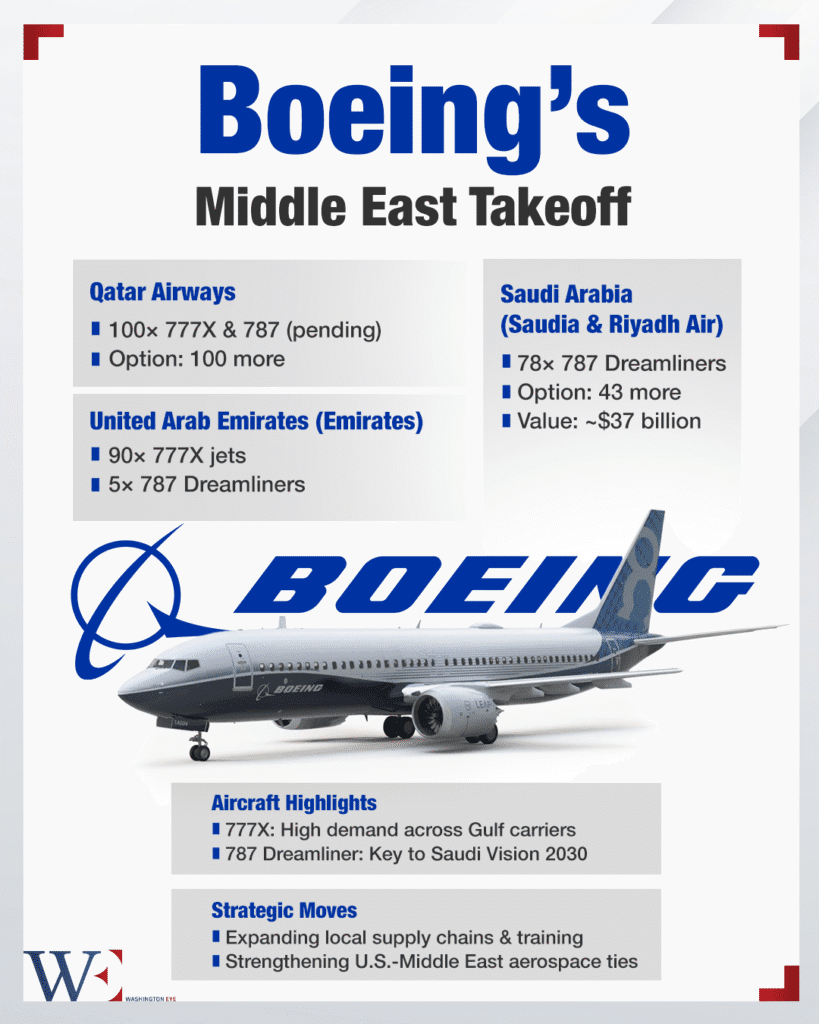As Boeing navigates the turbulence of a reshaped global aerospace industry, the firm finds itself pursuing an assertive expansion in the Middle East, even as its market prospects in China are stalling. This dichotomy not only underscores the evolving geopolitical contours of aviation commerce but also reveals how Boeing is recalibrating its global strategy amid intensifying East-West rivalries.
Middle East: Boeing’s New Strategic Heartland
The Middle East has become Boeing’s most dependable and strategic growth frontier in the face of political and regulatory headwinds elsewhere. Across the Gulf, the U.S. aerospace giant has secured landmark deals and is cementing long-term partnerships that serve both commercial and geopolitical objectives.
In Qatar, Boeing is reportedly finalizing a substantial agreement with Qatar Airways for about 100 widebody aircraft, with options for an additional 100. The deal, reported ahead of President Trump’s expected visit to the Gulf, would primarily involve Boeing’s next-generation 777X and 787 models. This potential order comes as Qatar aims to revamp its long-haul capabilities and assert its global aviation stature, which Boeing is uniquely positioned to support.
But Boeing’s Middle Eastern thrust is far from limited to Qatar. In Saudi Arabia, Boeing has inked one of the most consequential deals in its recent history. In March 2023, the company secured an order for 78 Dreamliner jets (with an option for 43 more) from Saudia and the newly launched Riyadh Air. The total order—split between the two carriers—forms the backbone of the kingdom’s “Vision 2030” initiative, aiming to turn Saudi Arabia into a global tourism and transit hub while diversifying its economy beyond oil. This deal, valued at nearly $37 billion, is not merely commercial—it’s deeply strategic, reinforcing U.S.-Saudi economic ties amid a multipolar geopolitical landscape.
Meanwhile, in the United Arab Emirates, Boeing continues its long-standing collaboration with Emirates, the world’s largest operator of Boeing 777 aircraft. At the 2023 Dubai Airshow, Emirates placed a sweeping order for 90 Boeing 777X jets and five more 787 Dreamliners. With Emirates doubling down on long-haul capacity and cargo operations, Boeing remains its top supplier—fending off competition from Airbus in the process.
Together, these deals are not mere sales—they represent a strategic pivot. Boeing is entrenching itself in Middle Eastern supply chains, pilot training programs, and aircraft maintenance ecosystems, creating interdependencies that align with broader U.S. foreign policy in the region.
China: An Unraveling Relationship
Boeing’s expansion in the Middle East starkly contrasts with its crumbling relationship with China, where geopolitical tensions and industrial self-reliance policies have turned the skies more hostile.
According to multiple reports, Beijing has effectively frozen new orders for Boeing aircraft. Domestic airlines must now seek central government approval before finalizing any deliveries. In a dramatic illustration of this freeze, a Boeing 737 Max intended for Xiamen Airlines was flown back to the U.S. without delivery, underscoring the paralysis in commercial transactions between Boeing and Chinese carriers.
This development follows mounting pressure within China to favor domestically-produced aircraft, particularly from COMAC (Commercial Aircraft Corporation of China), whose C919 narrow-body jet has been positioned as a national alternative to Boeing’s 737 Max. Boeing CEO Dave Calhoun has recently warned that the company may reconsider production volumes for China-bound jets if the regulatory blockade continues.
Not only is Boeing losing out on what was once its largest single-nation market outside the U.S., but it’s also watching its rival Airbus strengthen its foothold in the country. Airbus recently inaugurated a second final assembly line for A320s in Tianjin, signaling European willingness to co-invest in Chinese aerospace ambitions in a way the U.S. cannot, or will not, match.
Strategic Implications: A Realignment in Global Aerospace
The divergence between Boeing’s fortunes in the Middle East and China reflects broader shifts in global aviation—both commercial and political. Boeing’s proactive engagement with Qatar, Saudi Arabia, and the UAE not only secures vital commercial wins but also aligns with U.S. interests in maintaining influence in a region that is itself diversifying its global partnerships, including with China and Russia.
Conversely, Boeing’s entanglement in the U.S.-China rivalry illustrates the risks of relying heavily on politically exposed markets. The rapid unraveling of its Chinese pipeline—both in terms of orders and delivery approvals—demonstrates how swiftly state-level politics can undercut commercial viability.
In the near term, Boeing will likely continue to redirect aircraft originally destined for China to airlines in friendlier regions—including Southeast Asia, Africa, and the Middle East. However, this stopgap solution cannot fully compensate for the scale of the Chinese market.
The long-term implications are twofold: first, Boeing must deepen and diversify its geopolitical hedges, leaning into strategic markets that align with U.S. diplomatic priorities. Second, the company must double down on innovation and production efficiency, lest it cede further ground to Airbus or emerging players like COMAC.
A Final Note: Boeing’s Global Balancing Act
Boeing’s future now depends on how well it can navigate an increasingly fragmented global landscape. The Middle East has emerged as a vital buffer against its losses in China, but this is not a guaranteed lifeline. As Gulf states court partnerships with both Western and Eastern powers, Boeing must continue to prove its technological and operational superiority. In a world where aerospace deals increasingly carry geopolitical weight, Boeing is no longer just building planes—it’s building alliances.














